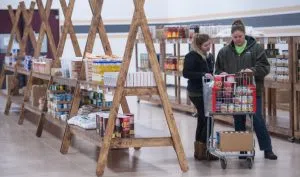
(Photo credit/ Don Hamilton for USDA vis the North Dakota Monitor)
(North Dakota Monitor) -Amid a monthlong food shortage affecting tribal food assistance programs, U.S. Senators John Hoeven and Kevin Cramer of North Dakota urged Agriculture Secretary Tom Vilsack to swiftly and thoroughly rectify the situation.
“These shortages are a gross failure of program management and the USDA needs to promptly resolve this issue,” said Cramer in a statement to Buffalo’s Fire. “Participating families need certainty that their food will show up on time.”
Earlier this year, the U.S. Department of Agriculture’s warehouse consolidation disrupted nationwide distribution, leaving many commodity food programs – critical for children and elders – without staples like meat, cheese, frozen vegetables and fruit juice.
Six senators from both sides of the aisle, including Hoeven and Cramer, wrote in an Aug. 23 letter that while the USDA is mitigating the persistent delivery issues, “more must be done.”
“This letter is about getting answers, solving the problems … and pressing to ensure that tribes are properly consulted on the administration of this program moving forward,” Hoeven said in a statement to Buffalo’s Fire.
Mary Greene-Trottier, director of the Spirit Lake Nation Food Distribution Program in Fort Totten, said that the resources Secretary Vilsack mobilized already have been “tremendous.”
“I’m glad congressional leaders are heeding the call to urgency and I commend them for that,” she said.
In their letter, senators joined food program directors in calling for long-term guardrails and strategies to “prevent a situation like this from occurring in the future.”
Delayed, incomplete or missing deliveries skyrocketed when the U.S. Department of Agriculture switched to a single distribution and warehouse provider in April. Missouri-based contractor Paris Brothers lacked the staffing and infrastructure necessary for a smooth transition.
Many commodity food programs – accustomed to monthly replenishment – faced shortages or ran out of stock when delivery trucks didn’t arrive until weeks after they were scheduled.
Program directors have been in overdrive, working to establish a line of communication to secure deliveries. They have switched to multiple food suppliers and funding streams to ensure clients can take home the staple foods they need.
The legislators emphasized that these food shortages are especially impactful during the summer months when many families rely on commodity food programs in lieu of school meals. Food distribution programs are critical in combating the “summer slide,” where students’ education level regresses without consistent resources.
In early August, deliveries increased but needed to be improved to address the significant backlog. After more than three months of persistent shortages, USDA authorized food distribution programs to utilize separate funds and provided $11 million to purchase foods and bolster inventory.
Food banks, vendors, and tribal leaders consistently reach out to tribal food assistance programs, offering resources and support. This “shows they care,” Greene-Trottier said.
Greene-Trottier noted it was unfortunate the attention was on a negative experience within the food distribution programs, which are critical community hubs. “I really hope this sheds a light on the important work we do,” Greene-Trottier said.
More than 50,000 participants in food distribution programs on reservations rely on the monthly food supply instead of the Supplemental Nutrition Assistance Program, which can be hard to access on reservations. In 2023, the Commodity Supplemental Food Program served almost 700 million low-income seniors.
Greene-Trottier will travel to Washington, D.C., on Sept. 12 for a consultation between tribal leaders and government officials. She hopes the discussion will establish strategies for long-term solutions.
__________________________________________________









